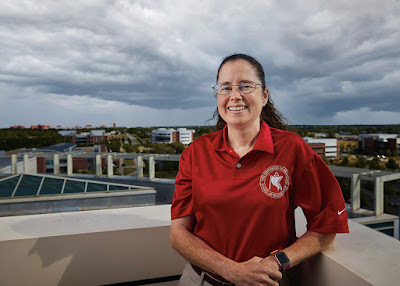Can OU Research Team Clear Up Biases in Artificial Intelligence?
Group’s goal is to help environmental scientists learn the basics of AI.
There’s no doubt that artificial intelligence is embedded in our everyday lives. From smartphones to ridesharing apps to mobile check deposits, AI is so pervasive that we rarely think about how it works.
For one University of Oklahoma scientist, however, artificial intelligence and machine learning are at the forefront of her work – expressly as it relates to weather. Amy McGovern, Ph.D., leads the National Science Foundation AI Institute for Research on Trustworthy AI in Weather, Climate, and Coastal Oceanography at the University of Oklahoma.
An American Meteorological Fellow, McGovern has been studying severe weather phenomena since the late 1990s. During her career, she has witnessed a rapid emergence in the AI field, all while developing what she hopes are trustworthy AI methods to avert weather and climate disasters.
Lately, however, McGovern and researchers from Colorado and Washington have noticed grave disparities in AI, noting that the methods are not objective, especially when it comes to geodiversity.
“Artificial intelligence algorithms are based on mathematical formulas that are seen as objective; however, there is a bias toward areas with higher populations, as well as areas that are more affluent,” said McGovern, a professor at OU’s School of Computer Science and School of Meteorology.
“For example, if more people live in an area, there is a higher chance that someone observes and reports a hail or tornado event. This can bias the AI model to over-predict hail and tornadoes in urban areas and under-predict severe weather in rural towns,” she said.
AI tools, whether forecasting hail, wind or tornadoes, are assumed to be inherently objective. They aren’t, McGovern says.
Raising Awareness
The team recently published a paper titled “Why We Need to Focus on Developing Ethical, Responsible, and Trustworthy AI Approaches for Environmental Sciences.” Published by Cambridge University Press, the paper will appear in the inaugural issue of Environmental Data Science.
The researchers are exploring ethical AI methods, specifically in the field of environmental sciences. “Whether involved in teaching, industry or government, environmental scientists are absolutely essential for developing meaningful AI tools, and more educational resources are needed to help environmental scientists learn the basics of artificial intelligence so they can play a leading role in future developments,” McGovern said.
The group sees ethics in AI in the environmental sciences as an emerging trend in education. “With the rapid emergence of data science techniques in the sciences and the societal importance of many of these applications, there is an urgent need to prepare future scientists to be knowledgeable,” McGovern said.
AI systems can be as flawed as the people who create them and can unintentionally do more harm than good if not developed and applied responsibly, McGovern says. “We hope our work is a major step toward making AI systems more ethically informed in environmental science.”
Full paper available here. In addition to McGovern, the research team includes:
* Imme Ebert-Uphoff, Ph.D., an electrical and computer engineering professor at Colorado State University, and the machine learning lead for the Cooperative Institute for Research in the Atmosphere;
* Ann Bostrom, Ph.D., an environmental policy professor at the University of Washington; and
* David John Gagne, a machine learning scientist at the National Center for Atmospheric Research who earned a doctorate in meteorology from OU in 2016.
Environmental Data Science is a new open-access venue for the transformative potential of artificial intelligence and data science in addressing environmental challenges.
To learn more about the Gallogly College of Engineering at the University of Oklahoma, visit www.ou.edu/coe.
Learn about Amy McGovern's journey to Oklahoma in Sooner Magazine.
Photo by Travis Caperton for Sooner Magazine.
By Lorene A. Roberson, OU Gallogly College of Engineering



